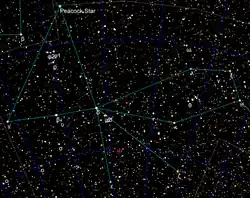HD 186302
| Observation data Epoch J2000 Equinox J2000 | |
|---|---|
| Constellation | Pavo |
| Right ascension | 19h 49m 06.43036s[1] |
| Declination | −70° 11′ 16.7033″[1] |
| Apparent magnitude (V) | 8.76±0.01[2] |
| Characteristics | |
| Spectral type | G3/5 V[3] |
| B−V color index | 0.67[4] |
| Astrometry | |
| Radial velocity (Rv) | −1.3±0.3[5] km/s |
| Proper motion (μ) | RA: −24.004[1] mas/yr Dec.: −38.804[1] mas/yr |
| Parallax (π) | 17.6309±0.0147 mas[1] |
| Distance | 185.0 ± 0.2 ly (56.72 ± 0.05 pc) |
| Absolute magnitude (MV) | +5.11[6] |
| Details[7] | |
| Mass | 0.97±0.01 M☉ |
| Radius | 0.95±0.01 R☉ |
| Surface gravity (log g) | 4.47±0.01 cgs |
| Temperature | 5,675±15 K |
| Metallicity [Fe/H] | −0.03[8] dex |
| Rotational velocity (v sin i) | 2.30[8] km/s |
| Age | 4.5±0.81 Gyr |
| Other designations | |
| HD 186302, HIP 97507, 2MASS J19490644-7011167, CD−70°1724 | |
| Database references | |
| SIMBAD | data |
HD 186302 (also designated HIP 97507)[9] is a star in the constellation of Pavo. It is 185 light-years (57 parsecs) away from Earth, with an apparent magnitude of 8.76.[9] It was identified in November 2018 as a potential solar sibling to the Sun, like HD 162826. Similar in spectrum and size, it was suspected to have formed in the same stellar nursery as the Sun 4.6 billion years ago.[10] However, a common origin with the Sun was found to be unlikely in a 2019 paper, as HD 186302's galactic orbit is very different from the Sun's.[11]
See also
References
- ^ a b c d e Vallenari, A.; et al. (Gaia collaboration) (2023). "Gaia Data Release 3. Summary of the content and survey properties". Astronomy and Astrophysics. 674: A1. arXiv:2208.00211. Bibcode:2023A&A...674A...1G. doi:10.1051/0004-6361/202243940. S2CID 244398875. Gaia DR3 record for this source at VizieR.
- ^ Høg, E.; Fabricius, C.; Makarov, V. V.; Urban, S.; Corbin, T.; Wycoff, G.; Bastian, U.; Schwekendiek, P.; Wicenec, A. (March 2000). "The Tycho-2 catalogue of the 2.5 million brightest stars". Astronomy and Astrophysics. 355: L27 – L30. Bibcode:2000A&A...355L..27H. ISSN 0004-6361.
- ^ Houk, N.; Cowley, A. P. (1975). University of Michigan Catalogue of two-dimensional spectral types for the HD stars. Volume I. Declinations −90° to −53°. Bibcode:1975mcts.book.....H.
- ^ Gomes Da Silva, J.; Santos, N. C.; Adibekyan, V.; Sousa, S. G.; Campante, T. L.; Figueira, P.; Bossini, D.; Delgado-Mena, E.; Monteiro, M. J. P. F. G.; De Laverny, P.; Recio-Blanco, A.; Lovis, C. (2021). "Stellar chromospheric activity of 1674 FGK stars from the AMBRE-HARPS sample. I. A catalogue of homogeneous chromospheric activity". Astronomy and Astrophysics. 646: A77. arXiv:2012.10199. Bibcode:2021A&A...646A..77G. doi:10.1051/0004-6361/202039765. S2CID 242898977.
- ^ Gontcharov, G. A. (November 2006). "Pulkovo Compilation of Radial Velocities for 35,495 Hipparcos stars in a common system". Astronomy Letters. 32 (11): 759–771. arXiv:1606.08053. Bibcode:2006AstL...32..759G. doi:10.1134/S1063773706110065. eISSN 1562-6873. ISSN 1063-7737. S2CID 119231169.
- ^ Anderson, E.; Francis, Ch. (May 2012). "XHIP: An extended hipparcos compilation". Astronomy Letters. 38 (5): 331–346. arXiv:1108.4971. Bibcode:2012AstL...38..331A. doi:10.1134/S1063773712050015. eISSN 1562-6873. ISSN 1063-7737. S2CID 119257644.
- ^ Adibekyan, V.; De Laverny, P.; Recio-Blanco, A.; Sousa, S. G.; Delgado-Mena, E.; Kordopatis, G.; Ferreira, A. C. S.; Santos, N. C.; Hakobyan, A. A.; Tsantaki, M. (2018). "The AMBRE project: Searching for the closest solar siblings". Astronomy and Astrophysics. 619: A130. arXiv:1810.01813. Bibcode:2018A&A...619A.130A. doi:10.1051/0004-6361/201834285. S2CID 119202092.
- ^ a b Llorente de Andrés, F.; Chavero, C.; de la Reza, R.; Roca-Fàbrega, S.; Cifuentes, C. (October 2021). "The evolution of lithium in FGK dwarf stars". Astronomy & Astrophysics. 654: A137. arXiv:2108.05852. Bibcode:2021A&A...654A.137L. doi:10.1051/0004-6361/202141339. eISSN 1432-0746. ISSN 0004-6361.
- ^ a b "HD 186302". SIMBAD. Centre de données astronomiques de Strasbourg. Retrieved November 24, 2018.
- ^ Matt Williams (2018-11-21). "Astronomers Find One of the Sun's Sibling Stars. Born From the Same Solar Nebula Billions of Years Ago". Universe Today. Retrieved 2022-10-07.
- ^ Leung, Henry W.; MacKereth, J Ted; Hunt, Jason A S.; Portegies Zwart, Simon; Bovy, Jo; Price-Jones, Natalie; Webb, Jeremy J. (2020). "Searching for solar siblings in APOGEE and Gaia DR2 with N-body simulations". Monthly Notices of the Royal Astronomical Society. 494 (2): 2268–2279. arXiv:1910.01646. Bibcode:2020MNRAS.494.2268W. doi:10.1093/mnras/staa788.
- ^ Batista, S. F. A.; Adibekyan, V. Zh.; Sousa, S. G.; Santos, N. C.; Delgado Mena, E.; Hakobyan, A. A. (2014), "Searching for solar siblings among the HARPS data", Astronomy & Astrophysics, 564: A43, arXiv:1403.1506, Bibcode:2014A&A...564A..43B, doi:10.1051/0004-6361/201423645, S2CID 56197806
